#isabelo de los reyes
Explore tagged Tumblr posts
Text
Notes on Anitismo - The Ancient Religion of the Philippines by Isabelo de los Reyes.
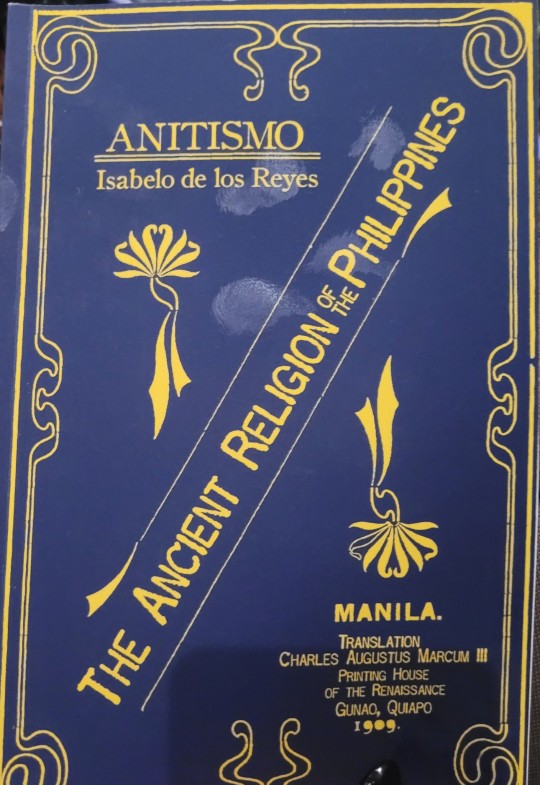
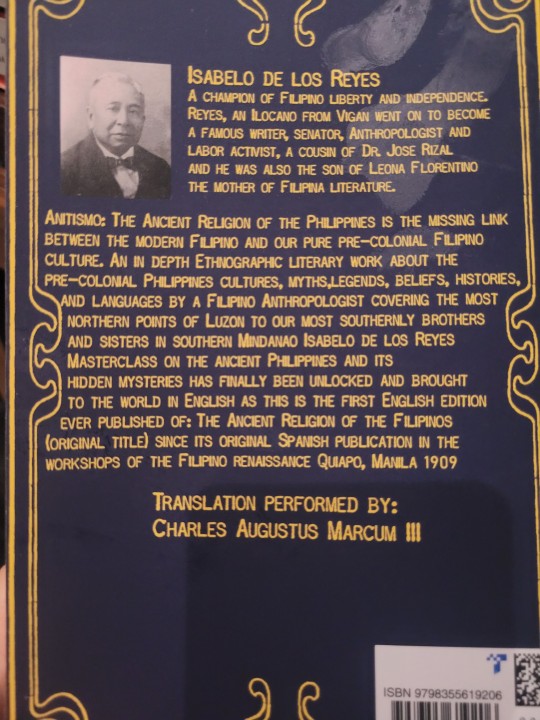
Keep in mind - this was written a while back.
Ancient Chronicles written by the Jesuit hispanic Friars state that at the that the first spaniards set foot in the Philippines from the coast of visayas to Manila there was a considerable population of Muslim converts
This was especially true for Mindanao due to conversion by Islamic teachers from Borneo
De los Reyes argues that because of this, to find native Filipino religion at its purest, we must look to the North
Distinguishing native religion without outside influence such as from Islam, Hinduism, Christianity etc can be tricky
However he argues that the traces of Native Filipino religion can be found in the stories superstitions and advice that belong to various Filipino ethnic groups (Tagalogs, Bicolanos, Zambalenos etc)
From the South of the country in Mindanao to the extreme North like Luzon, De los Reyes argues then native Filipino religion was consistent
This religion was Anitism or the Cult of Anito, meaning souls of the ancestors.
Anitism is not a monolithic religion and hosts a broad pantheon ranging from Gods to animals, nature, elements and space.
The Philippines had its own modern spiritism and De los Reyes argues this may have been the origins of the cults of "Romanist Saints" (Catholic saints) in the Philippines. By this I think he means that Filipino spirituality influenced how Filipinos proceeded with Catholic worship.
The oldest chronicles about the Philippines can be found in various museums and libraries (such as the National Library of Madrid, Covenant of St Augustine in Manila)
We can follow these chronicles, from when the Jesuit Pedro Quirino provided news of religion in the Philippines in 1604, followed by reproductions by others like the Jesuit Colin in 1663 and others such as Fr. Morga, Gonzalez de Mendoza, Aduarte etc.
Fr Morga said that Filipinos practised Anitism in certain regions like Camarines and Cagayan.
Some traditions would say that Manila and its regions were not originally native to the island - they were from Malayan islands and other remote areas.
Before the Spaniards arrived, Islamic teachers from Borneo came to preach and interacted with the locals
Their teachings and beliefs spread quickly throughout the Philippines
Fr. Grijalva writes that they (Filipinos) started adopting their traditions and took on their names.
De Los Reyes argues that Spanish conquistadors' arrival/conquest was delayed because Filipinos were already familiar with various religions and beliefs and also because of the hands of Datu Lapu Lapu. What I believe he is arguing is that Datu Lapu Lapu and the previous exposure Filipinos had to different religions at first delayed Spanish influence from spreading so quickly.
Other islanders who weren't under the control of the government in the Philippines has their beliefs influenced by religious preachers who travelled to them from the Straits of Malacca and the Red Sea.
An account, dated April 20th 1572 (preserved in the archives of India) which is from the conquest of Luzon details "In these towns, closest to the sea, they do not eat any pork, which the moors taught them. But if you ask them, they say they do not know Muhammed or his law." This account was reproduced by Wenceslao Retana.
In actuality, very few Filipinos could understand/read the teachings of the Koran despite the Islamic influence.
In Filipino traditions, reverence and worship was given to nature and the elements, and this was usually consistent throughout the islands.
Native Filipino religion beliefs include elements, animals, stars and ancestors.
Filipino religion in Manila and nearby areas was a mixture or Anitism, Buddhism, Hinduism and Islam brought by the Malays of Borneo.
Vocabulary included Sanskrit and Malay terms such as Bathala, meaning Lord.
However these terms are not used in Northern provinces.
De Los Reyes argues that Itnegs and other mountain tribes conserved and maintained the purest form of Filipino religion
In the Ilocos, Cagayan, Isabela and other provinces of Northern Luzon, native Filipino religion was more prevalent
Hindus and Buddhists converted many in Java and Malaysia.
However Muslim influence became dominant in 1478 - 60 years before the Dutch invasion.
According to Javanese legends, Hindus arrives in Java 78 years before Christ.
The first Malays came from the Minangkabau river region to establish cities in Malacca , Ojohor and Singapore in the 12th century, as per Malacca records.
In the 13th, 14th and 15th centuries, there were various Malaysian emigrations reaching the Philippines
De Los Reyes argues that Filipinos may have also populated the islands of Malaysia, and emigrations could have originated from strong winds coming down from the North.
The first Spaniards found the son of Lakandula, King of Manila, when they went to Borneo.
The emperor's master of ceremonies from Japan (Mr Fujita) argued that emigration likely came from the north and that Filipinos may have some relations to the Japanese.
According to Geographers and Historians of the Mariana Islands, what De Los Reyes calls the "know it all Spanish" - had no idea about interesting ruins found in Oceania, one of which was a prehistoric statue that was being held in the British museum.
He argues there may be hidden megaliths, artefacts, and remnants of lost civilisation in the Philippines, as seen in various locations such as : Butacan caves, Pangibalon Hill, Madias de Iloilo and Nasso.
#Philippines#pre colonial philippines#Filipino#Filipino history#Anitism#Filipino religion#Pinoy#Isabelo de los Reyes#History#Asia#Asian history#South east Asian history#Religion#ancient religion#South east asia#Colonialism#spanish colonial#Spanish colonialism#Philippines history#Philippine history#Anitismo#Keep in mind this was written a while ago so some terms may be outdated#I've tried to interpret some tricky parts the best I could#My ass who is from the Northern Philippines 🗿
66 notes
·
View notes
Photo

On this day, 7 July 1864, Filipino labour leader Isabelo de los Reyes was born in Vigan. He became a journalist and opponent of Spanish colonial rule, for which he was jailed and tortured. He was then deported to Spain and held in the infamous Montjuich Castle in Barcelona, alongside many anarchist political prisoners. In 1901 he was allowed to return to the Philippines, and he brought with him a library of books by socialists like Karl Marx and anarchists like Mikhail Bakunin. He founded the Unión Obrera Democrática Filipina, and helped organise several strikes. See our timeline of his life and activism on our Stories app, including sources and maps: https://stories.workingclasshistory.com/tag/9461/isabelo-de-los-reyes https://www.facebook.com/photo.php?fbid=657696179736934&set=a.602588028581083&type=3
116 notes
·
View notes
Text

…in June and July of 1896 thick swarms of locusts completely ruined the rice fields, and farmers faced a future that was bleak indeed. They already groaned under the hard yoke of the friar hacenderos, who far from remitting even a part of ground rent in consideration of the low prices, the locust plague and the drought, steadily increased it; and so the peasants, driven to desperation, swelled the ranks of the revolution.
Isabelo de los Reyes, taken from De la Costa, H., S.J. (1992). Revolution. I. De los Reyes (Ed.), Readings in Philippine History.
#i once had a ring#alternate history#webcomic#comic#philippines#philippine revolution#katipunan#andres bonifacio#balintawak
4 notes
·
View notes
Text
On CIA’s Intense Religious Efforts to Combat the “Christian Left” in the Philippines
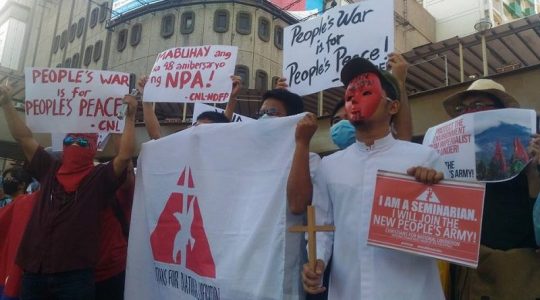
Excerpted from "A Commentary on the Compendium of the Social Doctrine of the Church" by Christians for National Liberation (in the Philippines)
More on the cultural field, the CIA and its conduits have used and continue to employ the Christian religion to disrupt and distort the progressive aspect of Christianity and the victory of the Filipino people against Spanish colonialism that made use of Catholicism in order to subjugate the Philippines for more than 300 years. It can even be construed that the CIA backed up financially the Iglesia ni Kristo (INK), founded by Felix Y. Manalo in 1914, which attracted a significant membership and started to build big I.N.K. churches after World War II. The CIA could have done this covertly in order to make the I.N.K. the Filipino opposite church of the Iglesia Filipina Independiente (IFI), founded on August 3, 1902 by Filipino Katipunan revolutionary priest Gregorio Labayan Aglipay with Union Obrera Democratica (UOD) labor leader Isabelo de los Reyes, Sr., popularly known as Don Belong. In fact, the US imperialists were very much displeased when they came to know that Obispo Maximo or Supreme Bishop Aglipay secretly gave support when the Socialist and Communist Parties of the Philippines merged in 1938 and when he expressed interest and enthusiasm in the universal theory of Marxism-Leninism after he read Marxist classics in Spanish sent by his friend, James S. Allen of the Communist Party US, as the bishop said in 1939:
The first one I read has already confirmed me in my convictions about communism and that the salvation of mankind lies only in its hands. I have always declared that we must concentrate all our efforts in making this a better world, without wasting anything in vain delusions about what lies beyond this life. And it gives me a thrill discovering that Lenin, Marx, Stalin and all the friends of the Proletariat are one with me in this.
The openness of Filipino Christians to struggle for national liberation, as shown by the Filipino Catholic clergy who joined the revolution against Spanish colonialism, and even to Marxism as manifested by Bishop Aglipay in his statement mentioned above, had led US imperialism to continue commissioning the CIA to persist in utilizing the Christian religion to hide the exploitation and oppression of US imperialism in the Philippines. For instance, the CIA initiated the entry of Christian “socialism,” which became the ideological foundation of the Christian Social Movement (CSM) headed by Manglapus and Manahan among pro-US imperialist politicians to counter Filipino nationalist politicians, led by the late Senator Claro M. Recto. Senator C. M. Recto was a staunch anti-US imperialist critic and was believed to have been a victim of the CIA, as he died mysteriously of heart attack, though he had no known heart ailment, in Rome, Italy after an appointment with two Caucasians in business suits in 1958. During the 1960s to the 1970s, the CIA established the Campus Crusaders for Christ (CCC) in various universities and colleges throughout the Philippines; the New Tribes Mission (NTM) stations and the Summer Institute of Linguistics (SIL) centers were formed by the CIA in the mountainous areas of the national minorities throughout the Philippines. And since the 1980s up to the present period, all sorts of CIA-backed charismatic congregations, the Dating Daan of Eli Soriano, the Sonship Kingdom of Pastor Apollo Quiboloy (a megalomaniac and self-appointed Son of God in Davao and a friend of tyrant Duterte; has expropriated Lumad lands; owns Son Shine Radio with 16 transmitters stationed strategically throughout the country, fully supports tyrant Duterte’s Build, Build, Build projects; and actively participates in the surrender campaign of the National Task Force to End Local Communist Armed Conflict or NTF-ELCAC), “praise the Lord” groups, “Christ to the Orient” and “free believers” have proliferated. And usually, the use of the Bible and Christianity for the CIA-backed evangelists is to attack the mainline Christian Churches that adhere to human rights in Philippine society.
Currently in this 3rd millennium of Christianity, the newest “church,” that may have been introduced by the CIA in the Philippines, is the “Christ the Way of Salvation: Divine Covenant International Church.” It projects itself as a global church and claims to have many congregations of worshipers in the US, Spain, the Philippines, and other countries. Based on the findings of the CNL research team, this newest “international Church” has worshipping centers in various places in the Philippines such as in Manabo and Pilar, Abra; Nueva Era, Ilocos Norte; Rosales, Pangasinan; Romblon; and other areas of the country. This “International church” sees itself as very different from the mainline Christian Churches (RC, UCCP, IFI, UMC, ECP, LCP), though almost all its members come from the mainline Christian Churches.
Some may question the veracity if the “Christ the Way of Salvation: Divine Covenant International Church” is, indeed, a CIA-created and -inspired one. For one thing, the CIA makes use of various international fronts and conduits to conceal its mission to maintain US imperialist global hegemony. But one may conclude that it may have been established by the CIA: first, when such a Christian church is “international” in scope and is very well-funded; second, though biblically based, a so-called “International Church” limits itself to only a few New Testament passages and does not mention the prophets of the Old Testament and the various denunciations by Jesus Christ addressed to the rich and powerful; third, it does not recognize as “apostolic” the traditions of the mainline Christian Churches (particularly the Roman Catholic and Orthodox in other countries); fourth, it considers itself as very different from the mainline Christian churches and does not worry itself about ecumenical concerns; fifth, it does not bother itself as regards the global problems of wars, poverty and inequalities among peoples and nations; and, sixth, it merely stresses spiritual conversion and salvation of individual persons. One example of this is defined and found in The Way of Salvation. It states:
There are differences within Christian churches that have created various denominations… These denominations have differences regarding their beliefs in God and salvation… [But] the church that preaches the true gospel today is the true one that continues the teachings of Jesus Christ and the apostles… There are three integral phases in the complete Christian conversion and salvation…: (1) Confess Jesus As Lord; (2) Receive the Life of Christ… by accepting the three sacraments: baptism, footwashing [CNL], and Holy Communion; [and] (3) Live by the Spirit.
Some Church leaders and CNL cadres in Northern Luzon, Philippines even suspect that CIA elements may also be using the International Criminal Police Organization or Interpol in order to spy on the activities of the progressive Church people. The basis of this is the fact that the CNL research team found out in 2019 that some ordained priests and ministers in Northern Luzon were issued Interpol badges at ₱500 per badge. One priest was, in fact, given an Interpol badge, ranking him as a brigadier general! Those given Interpol badges were told to submit regularly their findings on people involved in various criminalities, including those engaged in the communist insurgency. Such suspicion by some Church leaders and CNL cadres may have been based on the fact that even the United Nations’ Security Council is under the direct control of US imperialism and other imperialist powers. Therefore, it is easy to assume the great possibility that the CIA forces currently at work in the Philippines are already using the Interpol in order to spy on the CNL, even though the Interpol clearly states in its international policy that it “is strictly non-political and is forbidden to undertake any activities of a religious, racial, or military nature; and only government-approved police bodies may hold Interpol membership.”
It must, therefore, be very clear to all Christians—the ordained, the religious, the laity—that US imperialism and the CIA provocateurs go on using the Christian religion and the anti-communist propaganda to thwart the participation of Christians—the ordained, the religious and the laity— in the Philippine NDR which has a socialist perspective. And although it would be expounded on in the CNL’s 8th topic, CNL’s Concluding Remarks: God’s Kingdom as the Reign of Truth, Justice, Peace, Love, Equality and Liberation, all CNL members further pray that all Filipino Christians relegate the Church’s more than two-century old partiality to capitalism, be open to dialogue with Marxists, and be inspired by Pope Francis who said in his November 11, 2016 interview at the Vatican City: “It’s the communists who think like Christians.”
#christianity#catholic church#pope francis#communism#anti-communism#CIA#religion#new tribes mission#duterte#rodrigo duterte#philippines#politics#counterinsurgency#theology#Iglesia Filipina Independiente#CNL#christians for national liberation
1 note
·
View note
Text
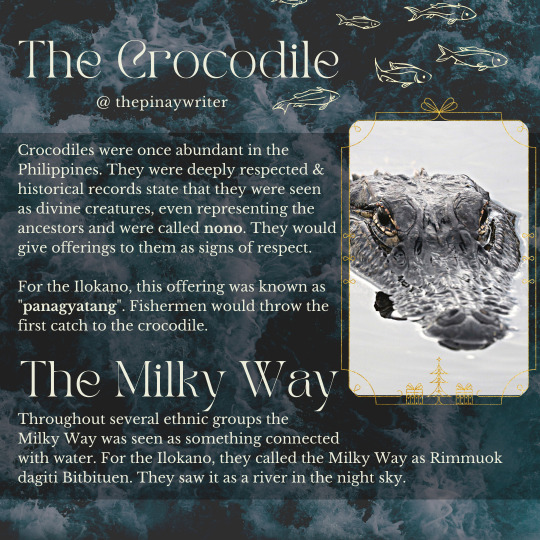

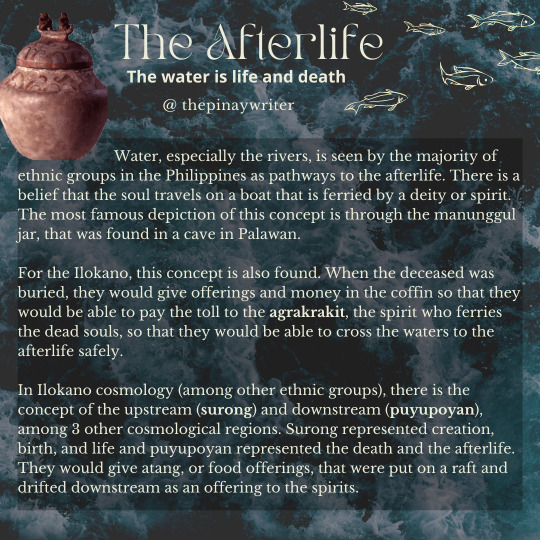
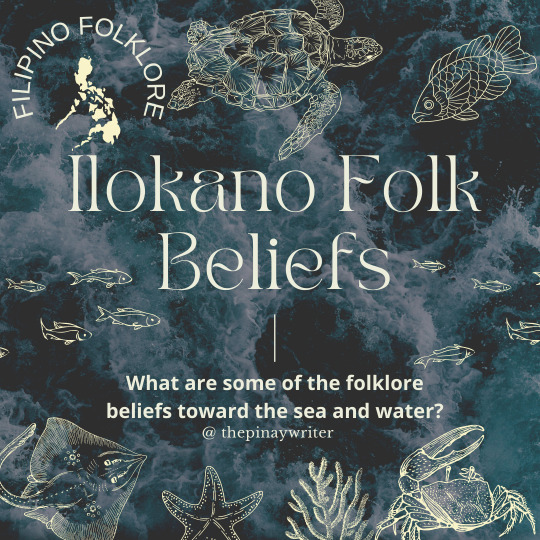
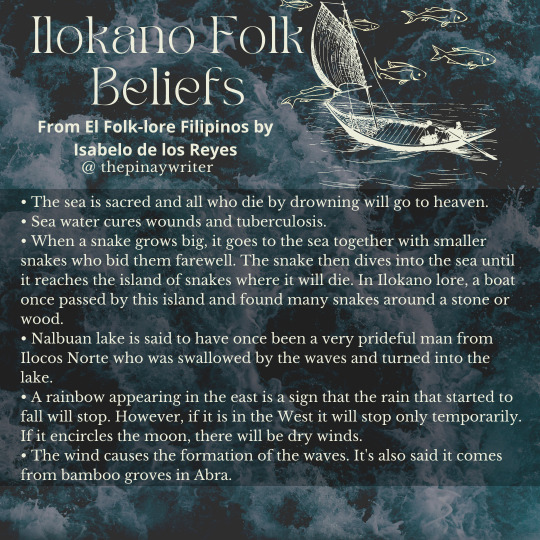
🌊 Water is life. It is death. It represents a cosmological cycle of both in many ethnic groups in the Philippines.
Today we are going to discuss and learn about some Ilokano folklore on the sea and water. From the Ilokano god of the rivers and sea, Apo Litao, to the cosmological beliefs involving the water and sea.
🌿 RECOMMENDED READING:
For more on Ilokano folklore and practices, I highly suggest reading El Folk-lore Filipino by Isabelo de los Reyes and Way of the Ancient Healer by Virgil Mayor Apostol @ virgilmapostol on IG . (Both books which I credit and gained all the info listed here).
The lovely sirena artwork pictured on the second photo is by Sarah DeMonteverde @ ilandtuitles on IG (go follow her because her artwork is amazing!) ❤
FOLLOW ME ON SOCIAL MEDIA FOR MORE!
▪️@ IG ( https://www.instagram.com/thepinaywriter/ )
▪️@ Tiktok ( https://www.tiktok.com/@thepinaywriter )
▪️@ Twitter ( https://twitter.com/thepinaywriter )
▪️@ Blog ( https://thepinaywriter.com)
▪️@ Spiritual and Botanical Shop ( https://hirayabotanicals.com)
#filipino#philippines#precolonial#deity#anito#diwata#pinoy#filipino folklore#folklore#myth#mythology#filipino mythology#filipino myths#philippine mythology#ilokano#ilocano
550 notes
·
View notes
Text
There are around 7 million people who speak Ilocano as their first language, mainly in Northern Luzon, the provinces of La Union and Ilocos, the Cagayan Valley, Babuyan, Mindoro, and Mindanao. Ilokano is also used as a lingua franca in trade, commerce, and everyday conversation by perhaps another 2 million speakers in the northern parts of Luzon. Ilocano is more widely spoken by ethnic groups from the country's northside than Tagalog, which is also its official language. Ilocano does not, however, have official status at this time; it is merely a regional tongue. Only the first few classes of elementary school use it.
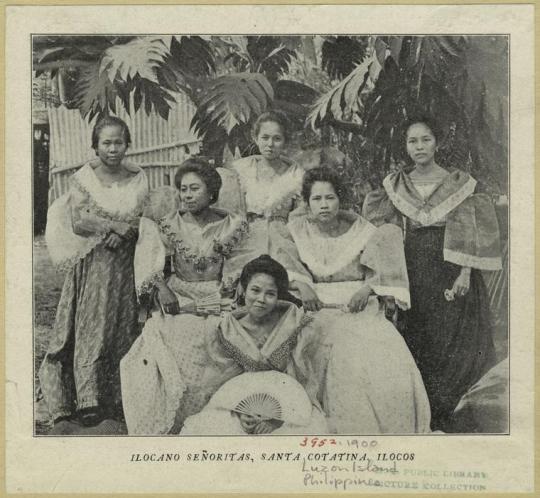
The Ilocanos were the first ethnic group from the Philippines to immigrate in substantial numbers to North America, establishing sizable settlements in Hawai'i, California, and the Pacific.
Ilocano literature, also known as Iloko literature, refers to the literary creations of authors of Ilocano origin, regardless of the language(s) they have written in, including Ilocano, English, Spanish, and other foreign and Philippine languages. The words "Iloko" and "Ilocano" are distinct in the Ilocano language.
HISTORY OF ILOKO LITERATURE
Pre-colonial Iloko Literature-were composed of folk songs, riddles, proverbs, lamentations ( dung-aw), and epic stories written or oral form.
•Ancient Ilokano poets expressed themselves in folk and war songs.
DALLOT- an improvised, versified and at times impromptu long poem delivered in a sing-song manner.
FRANCISCO LOPEZ- an Augustinian friar
-translated the earliest written Iloko poems(romances) from Spanish

-also translated the DOCTRINA CRISTIANA (Cardinal Bellarmine)- the first book to be printed in Iloko.
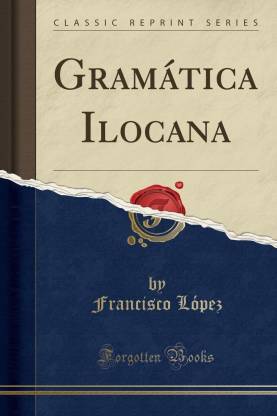
GRAMATICA ILOKANA (1895)
- where the study of Iloko poetry could be found
- based on Lopez’s Arte de la Legua Iloca
PEDRO BUCANEG
- collaborated with Lopez in the translation of the Doctrina into Iloko
- credited for having been the first known
Ilokano poet
- Father of Ilokano Poetry and Literature
- blind since childhood
- authored the popular epic Biag ni Lam-ang (Life of Lam-ang) in the 17th
Ilocano Literary Works
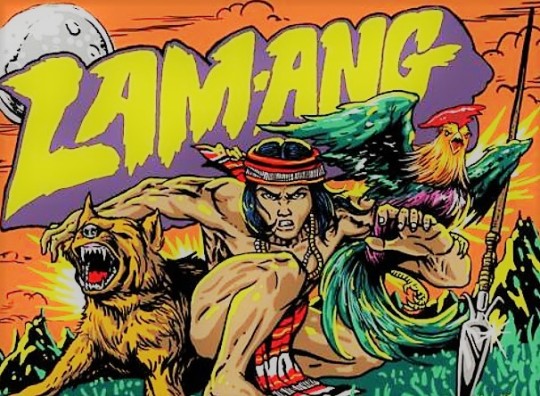
•The poem is thought to have originated as oral literature in pre-colonial times, evolving as it is transmitted from poet to poet and generation to generation. The poem's first written documentation is sometimes credited to the blind Ilocano poet and preacher Pedro Bucaneg, but historian E. Arsenio Manuel gives that honor to Fr. Blanco of Narvacan, who collaborated with publicist and folklorist Isabelo de los Reyes.
The Biag ni Lam-ang narrative teaches us about Philippine history and provides insight into the methods our early ancestors used to identify suitable hunting grounds and establish territorial control. Because our country is full with so many wonderful things and is so magical, it is the ideal place for children to reside. We think that there are living things about us that are unseen to the naked sight, but can nevertheless see us and feel their presence thanks to our instincts.

•In the 1943 short story "My Father Goes to Court," two families with vastly different levels of wealth are shown to be at odds with one another. The plot revolves around the way the impoverished family deals with hardships in life and the way of life of the wealthy family. The wealthy family has a spacious home and servants because they have been awarded a considerable quantity of wealth. Rarely did the wealthy family's children leave their home. Given their high level of purchasing power, the wealthy family can purchase everything they desire and just enjoy it in the comfort of their own home. Too much time spent at home results in inactivity. As they were depicted in the story as being skinny and pale, this prevents them from being healthy.
This tale shows how useless money is without good health. In the narrative, it was mentioned that the underprivileged kids engaged in a variety of physical activities, which is undoubtedly better for their health. The best anti-depressant is a healthy lifestyle or exercise. It also has a good impact on how our brain functions.
Appreciating Ilocano Literature
One of the most dynamic Filipino literary traditions through the ages is Ilocano literature. Ilocano regions are also among the literature of the Philippines' most active tributaries.
We Ilocanos have a rich literature as we have published many stories, songs and many other literary pieces. We should appreciate these because it depicts our culture, traditions, behaviors through literary works.
Literature allows a person to step back in time and learn about life on Earth from the ones who walked before us. We can gather a better understanding of culture and have a greater appreciation of them. We learn through the ways history is recorded, in the forms of manuscripts and through speech itself. Humanity is reflected in literature, and literature helps us to comprehend one another. We can start to understand someone else's way of thinking by listening to their voice. I think literature is significant because it serves a purpose, and books start conversations in a world that is growing more and more disconnected from interpersonal interaction.
4 notes
·
View notes
Text
The Literary Forms in Philippine Literature
by: Christine F. Godinez-Ortega
The diversity and richness of Philippine literature evolved side by side with the country's history. This can best be appreciated in the context of the country's pre-colonial cultural traditions and the socio-political histories of its colonial and contemporary traditions.
The average Filipino's unfamiliarity with his indigenous literature was largely due to what has been impressed upon him: that his country was "discovered" and, hence, Philippine "history" started only in 1521.
So successful were the efforts of colonialists to blot out the memory of the country's largely oral past that present-day Filipino writers, artists and journalists are trying to correct this inequity by recognizing the country's wealth of ethnic traditions and disseminating them in schools and in the mass media.
The rousings of nationalistic pride in the 1960s and 1970s also helped bring about this change of attitude among a new breed of Filipinos concerned about the "Filipino identity."
Pre-Colonial Times
Owing to the works of our own archaeologists, ethnologists and anthropologists, we are able to know more and better judge information about our pre-colonial times set against a bulk of material about early Filipinos as recorded by Spanish, Chinese, Arabic and other chroniclers of the past.
Pre-colonial inhabitants of our islands showcase a rich past through their folk speeches, folk songs, folk narratives and indigenous rituals and mimetic dances that affirm our ties with our Southeast Asian neighbors.
The most seminal of these folk speeches is the riddle which is tigmo in Cebuano, bugtong in Tagalog, paktakon in Ilongo and patototdon in Bicol. Central to the riddle is the talinghaga or metaphor because it "reveals subtle resemblances between two unlike objects" and one's power of observation and wit are put to the test. While some riddles are ingenious, others verge on the obscene or are sex-related.
The proverbs or aphorisms express norms or codes of behavior, community beliefs or they instill values by offering nuggets of wisdom in short, rhyming verse.
The extended form, tanaga, a mono-riming heptasyllabic quatrain expressing insights and lessons on life is "more emotionally charged than the terse proverb and thus has affinities with the folk lyric." Some examples are the basahanon or extended didactic sayings from Bukidnon and the daraida and daragilon from Panay.
The folk song, a form of folk lyric which expresses the hopes and aspirations, the people's lifestyles as well as their loves. These are often repetitive and sonorous, didactic and naive as in the children's songs or Ida-ida (Maguindanao), tulang pambata (Tagalog) or cansiones para abbing (Ibanag).
A few examples are the lullabyes or Ili-ili (Ilongo); love songs like the panawagon and balitao (Ilongo); harana or serenade (Cebuano); the bayok (Maranao); the seven-syllable per line poem, ambahan of the Mangyans that are about human relationships, social entertainment and also serve as a tool for teaching the young; work songs that depict the livelihood of the people often sung to go with the movement of workers such as the kalusan (Ivatan), soliranin (Tagalog rowing song) or the mambayu, a Kalinga rice-pounding song; the verbal jousts/games like the duplo popular during wakes.
Other folk songs are the drinking songs sung during carousals like the tagay (Cebuano and Waray); dirges and lamentations extolling the deeds of the dead like the kanogon (Cebuano) or the Annako (Bontoc).
A type of narrative song or kissa among the Tausug of Mindanao, the parang sabil, uses for its subject matter the exploits of historical and legendary heroes. It tells of a Muslim hero who seeks death at the hands of non-Muslims.
The folk narratives, i.e. epics and folk tales are varied, exotic and magical. They explain how the world was created, how certain animals possess certain characteristics, why some places have waterfalls, volcanoes, mountains, flora or fauna and, in the case of legends, an explanation of the origins of things. Fables are about animals and these teach moral lessons.
Our country's epics are considered ethno-epics because unlike, say, Germany's Niebelunginlied, our epics are not national for they are "histories" of varied groups that consider themselves "nations."
The epics come in various names: Guman (Subanon); Darangen (Maranao); Hudhud (Ifugao); and Ulahingan (Manobo). These epics revolve around supernatural events or heroic deeds and they embody or validate the beliefs and customs and ideals of a community. These are sung or chanted to the accompaniment of indigenous musical instruments and dancing performed during harvests, weddings or funerals by chanters. The chanters who were taught by their ancestors are considered "treasures" and/or repositories of wisdom in their communities.
Examples of these epics are the Lam-ang (Ilocano); Hinilawod (Sulod); Kudaman (Palawan); Darangen (Maranao); Ulahingan (Livunganen-Arumanen Manobo); Mangovayt Buhong na Langit (The Maiden of the Buhong Sky from Tuwaang--Manobo); Ag Tobig neg
Keboklagan (Subanon); and Tudbulol (T'boli).
The Spanish Colonial Tradition
While it is true that Spain subjugated the Philippines for more mundane reasons, this former European power contributed much in the shaping and recording of our literature. Religion and institutions that represented European civilization enriched the languages in the lowlands, introduced theater which we would come to know as komedya, the sinakulo, the sarswela, the playlets and the drama. Spain also brought to the country, though at a much later time, liberal ideas and an internationalism that influenced our own Filipino intellectuals and writers for them to understand the meanings of "liberty and freedom."
Literature in this period may be classified as religious prose and poetry and secular prose and poetry.
Religious lyrics written by ladino poets or those versed in both Spanish and Tagalog were included in early catechism and were used to teach Filipinos the Spanish language. Fernando Bagonbanta's "Salamat nang walang hanga/gracias de sin sempiternas" (Unending thanks) is a fine example that is found in the Memorial de la vida cristiana en lengua tagala (Guidelines for the Christian life in the Tagalog language) published in 1605.
Another form of religious lyrics are the meditative verses like the dalit appended to novenas and catechisms. It has no fixed meter nor rime scheme although a number are written in octosyllabic quatrains and have a solemn tone and spiritual subject matter.
But among the religious poetry of the day, it is the pasyon in octosyllabic quintillas that became entrenched in the Filipino's commemoration of Christ's agony and resurrection at Calvary. Gaspar Aquino de Belen's "Ang Mahal na Passion ni Jesu Christong Panginoon natin na tola" (Holy Passion of Our Lord Jesus Christ in Verse) put out in 1704 is the country's earliest known pasyon.
Other known pasyons chanted during the Lenten season are in Ilocano, Pangasinan, Ibanag, Cebuano, Bicol, Ilongo and Waray.
Aside from religious poetry, there were various kinds of prose narratives written to prescribe proper decorum. Like the pasyon, these prose narratives were also used for proselitization. Some forms are: dialogo (dialogue), Manual de Urbanidad (conduct book); ejemplo (exemplum) and tratado (tratado). The most well-known are Modesto de Castro's "Pagsusulatan ng Dalawang Binibini na si Urbana at si Feliza" (Correspondence between the Two Maidens Urbana and Feliza) in 1864 and Joaquin Tuason's "Ang Bagong Robinson" (The New Robinson) in 1879, an adaptation of Daniel Defoe's novel.
Secular works appeared alongside historical and economic changes, the emergence of an opulent class and the middle class who could avail of a European education. This Filipino elite could now read printed works that used to be the exclusive domain of the missionaries.
The most notable of the secular lyrics followed the conventions of a romantic tradition: the languishing but loyal lover, the elusive, often heartless beloved, the rival. The leading poets were Jose Corazon de Jesus (Huseng Sisiw) and Francisco Balagtas. Some secular poets who wrote in this same tradition were Leona Florentino, Jacinto Kawili, Isabelo de los Reyes and Rafael Gandioco.
Another popular secular poetry is the metrical romance, the awit and korido in Tagalog. The awit is set in dodecasyllabic quatrains while the korido is in octosyllabic quatrains. These are colorful tales of chivalry from European sources made for singing and chanting such as Gonzalo de Cordoba (Gonzalo of Cordoba) and Ibong Adarna (Adarna Bird). There are numerous metrical romances in Tagalog, Bicol, Ilongo, Pampango, Ilocano and in Pangasinan. The awit as a popular poetic genre reached new heights in Balagtas' "Florante at Laura" (ca. 1838-1861), the most famous of the country's metrical romances.
Again, the winds of change began to blow in 19th century Philippines. Filipino intellectuals educated in Europe called ilustrados began to write about the downside of colonization. This, coupled with the simmering calls for reforms by the masses gathered a formidable force of writers like Jose Rizal, Marcelo H. del Pilar, Mariano Ponce, Emilio Jacinto and Andres Bonifacio.
This led to the formation of the Propaganda Movement where prose works such as the political essays and Rizal's two political novels, Noli Me Tangere and the El filibusterismo helped usher in the Philippine revolution resulting in the downfall of the Spanish regime, and, at the same time planted the seeds of a national consciousness among Filipinos.
But if Rizal's novels are political, the novel Ninay (1885) by Pedro Paterno is largely cultural and is considered the first Filipino novel. Although Paterno's Ninay gave impetus to other novelists like Jesus Balmori and Antonio M. Abad to continue writing in Spanish, this did not flourish.
Other Filipino writers published the essay and short fiction in Spanish in La Vanguardia, El Debate, Renacimiento Filipino, and Nueva Era. The more notable essayists and fictionists were Claro M. Recto, Teodoro M. Kalaw, Epifanio de los Reyes, Vicente Sotto, Trinidad Pardo de Tavera, Rafael Palma, Enrique Laygo (Caretas or Masks, 1925) and Balmori who mastered the prosa romantica or romantic prose.
But the introduction of English as medium of instruction in the Philippines hastened the demise of Spanish so that by the 1930s, English writing had overtaken Spanish writing. During the language's death throes, however, writing in the romantic tradition, from the awit and korido, would continue in the novels of Magdalena Jalandoni. But patriotic writing continued under the new colonialists. These appeared in the vernacular poems and modern adaptations of works during the Spanish period and which further maintained the Spanish tradition.
The American Colonial Period
A new set of colonizers brought about new changes in Philippine literature. New literary forms such as free verse [in poetry], the modern short story and the critical essay were introduced. American influence was deeply entrenched with the firm establishment of English as the medium of instruction in all schools and with literary modernism that highlighted the writer's individuality and cultivated consciousness of craft, sometimes at the expense of social consciousness.
The poet, and later, National Artist for Literature, Jose Garcia Villa used free verse and espoused the dictum, "Art for art's sake" to the chagrin of other writers more concerned with the utilitarian aspect of literature. Another maverick in poetry who used free verse and talked about illicit love in her poetry was Angela Manalang Gloria, a woman poet described as ahead of her time. Despite the threat of censorship by the new dispensation, more writers turned up "seditious works" and popular writing in the native languages bloomed through the weekly outlets like Liwayway and Bisaya.
The Balagtas tradition persisted until the poet Alejandro G. Abadilla advocated modernism in poetry. Abadilla later influenced young poets who wrote modern verses in the 1960s such as Virgilio S. Almario, Pedro I. Ricarte and Rolando S. Tinio.
While the early Filipino poets grappled with the verities of the new language, Filipinos seemed to have taken easily to the modern short story as published in the Philippines Free Press, the College Folio and Philippines Herald. Paz Marquez Benitez's "Dead Stars" published in 1925 was the first successful short story in English written by a Filipino. Later on, Arturo B. Rotor and Manuel E. Arguilla showed exceptional skills with the short story.
Alongside this development, writers in the vernaculars continued to write in the provinces. Others like Lope K. Santos, Valeriano Hernandez Peña and Patricio Mariano were writing minimal narratives similar to the early Tagalog short fiction called dali or pasingaw (sketch).
The romantic tradition was fused with American pop culture or European influences in the adaptations of Edgar Rice Burroughs' Tarzan by F. P. Boquecosa who also penned Ang Palad ni Pepe after Charles Dicken's David Copperfield even as the realist tradition was kept alive in the novels by Lope K. Santos and Faustino Aguilar, among others.
It should be noted that if there was a dearth of the Filipino novel in English, the novel in the vernaculars continued to be written and serialized in weekly magazines like Liwayway, Bisaya, Hiligaynon and Bannawag.
The essay in English became a potent medium from the 1920's to the present. Some leading essayists were journalists like Carlos P. Romulo, Jorge Bocobo, Pura Santillan Castrence, etc. who wrote formal to humorous to informal essays for the delectation by Filipinos.
Among those who wrote criticism developed during the American period were Ignacio Manlapaz, Leopoldo Yabes and I.V. Mallari. But it was Salvador P. Lopez's criticism that grabbed attention when he won the Commonwealth Literay Award for the essay in 1940 with his "Literature and Society." This essay posited that art must have substance and that Villa's adherence to "Art for Art's Sake" is decadent.
The last throes of American colonialism saw the flourishing of Philippine literature in English at the same time, with the introduction of the New Critical aesthetics, made writers pay close attention to craft and "indirectly engendered a disparaging attitude" towards vernacular writings -- a tension that would recur in the contemporary period.
The Contemporary Period
The flowering of Philippine literature in the various languages continue especially with the appearance of new publications after the Martial Law years and the resurgence of committed literature in the 1960s and the 1970s.
Filipino writers continue to write poetry, short stories, novellas, novels and essays whether these are socially committed, gender/ethnic related or are personal in intention or not.
Of course the Filipino writer has become more conscious of his art with the proliferation of writers workshops here and abroad and the bulk of literature available to him via the mass media including the internet. The various literary awards such as the Don Carlos Palanca Memorial Awards for Literature, the Philippines Free Press, Philippine Graphic, Home Life and Panorama literary awards encourage him to compete with his peers and hope that his creative efforts will be rewarded in the long run.
With the new requirement by the Commission on Higher Education of teaching of Philippine Literature in all tertiary schools in the country emphasizing the teaching of the vernacular literature or literatures of the regions, the audience for Filipino writers is virtually assured. And, perhaps, a national literature finding its niche among the literatures of the world will not be far behind.
23 notes
·
View notes
Text
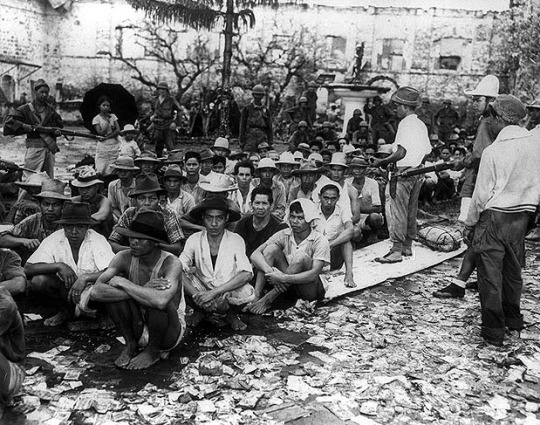
1945- Filipino guerillas talking over and silencing stand guarding captured members of the fascist paramilitary group MAKAPILI. The MAKAPILI were founded by former independence-activist turned fascist Benigno Ramos

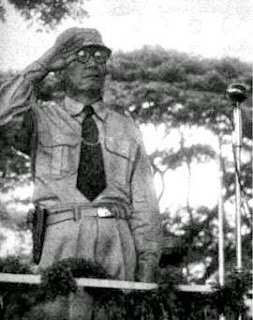
Ramos was a prominent political activist and critic of American colonialism in the Philippines. He is also famous for leading the Sakdalista (“Sakdal” is Tagalog for “Accuse”) movement and uprising which hoped to overthrow the oppressive regime of the Americans and their local collaborators. However Ramos anti-colonial movement was distinct from other left-wing movements such the PKP in its push towards ethno-nationalism. Whereas the PKP and earlier left wing Filipinos such as Isabelo de los Reyes emphasized strongly the need for anti-imperialism to be free of nationalistic chauvinism and xenophobia, Ramos used ethno-cultural-nationalism as the basis for his ideology (it is likely that Ramos was the target when the PKP’s precursor organization the Proletarian Labor Congress of the Philippines issued a manifesto attacking “fake labor unions” that seek to lead the people to ethnic chauvinism and fascism).
Ramos then fled to Japan where he shifted even further to the far-right and began advocating for Tagalog supremecism, saying that non-Tagalog Filipinos were the product of Spanish and American plots to divide the Tagalog nation. He returned to the Philippines in 1938 after staying in Japan for three years and founded the far-right Ganap Party. After the Japanese invasion in 1942 the Gapnap Party merged into the fascist KALIBAPI Party, the sole legal party during Japanese occupation with Ramos becoming one of its leaders.
Later on in 1944 the otherwise collaborationist Filipino president Jose Laurel would refuse a Japanese request that he begin conscription of Filipinos for the Imperial Japanese Army. In response to this Ramos and his followers founded the MAKAPILI, a fascist paramilitary group intended to assist the IJA in its anti-guerrilla activities in the Philippines and potentially demonstrate how Ramos and people like him might be more suited to lead the Philippines than the centrist establishment figure like Laurel the Japanese has originally picked.
45 notes
·
View notes
Text
Mourning for the Vulgos: A Commemoration of the Death Anniversary of Don Belong
Mourning for the Vulgos: A Commemoration of the Death Anniversary of Don Belong
The UP CSSP Folklore Studies Program presents the 7th Don Belong De Los Reyes Lecture, “Mourning for the Vulgos: Performing a Funerary Rite for Isabelo de los Reyes” which will be delivered by Prof. Jomar Cuartero on October 10, 2022, Monday, at 2:30 pm via zoom (see zoom registration below). The lecture series started in 2014 in honor of the father of Philippine folklore, Isabelo de los Reyes…

View On WordPress
0 notes
Photo
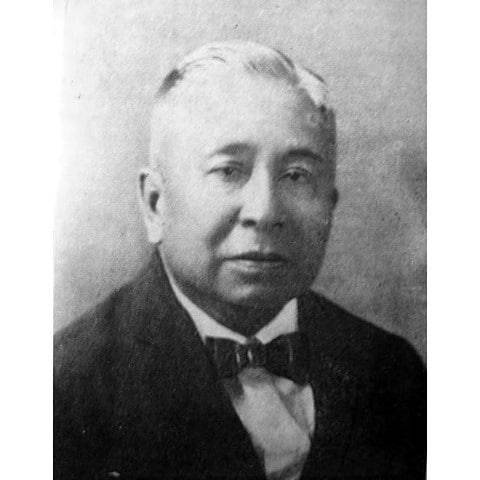
Reposted from @workingclasshistory On this day, 2 February 1902, the first workers' union federation in the Philippines, the Unión Obrera Democrática Filipina (Democratic Workers Union of the Philippines) was set up by Isabelo de los Reyes. By the following year it had 150 member unions with 20,000 members. The union's principles were based on the ideas of German communist Karl Marx and Italian anarchist Errico Malatesta. Reyes (pictured) had spent time in Spain where he was jailed for inciting strikes, came across anarchist and Marxist ideas in prison, and he brought large numbers of books by the likes of Karl Marx and Russian anarchist Mikhail Bakunin back to the Philippines with him. * For this and hundreds of other stories, check out our book, Working Class History: Everyday Acts of Resistance & Rebellion, available here (or on our link in bio on Instagram): https://shop.workingclasshistory.com/products/working-class-history-everyday-acts-resistance-rebellion-book (hier: FAUD-Lokal "V6") https://www.instagram.com/p/CK4m3T-lFh1/?igshid=1r3bxjce4w5n3
0 notes
Photo
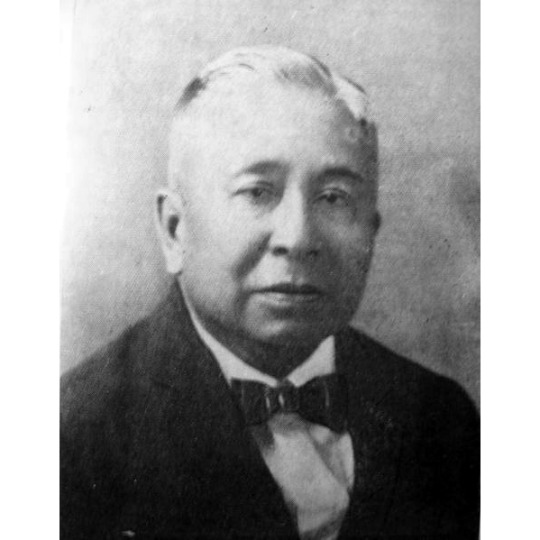
On this day, 2 February 1902, the first workers' union federation in the Philippines, the Unión Obrera Democrática Filipina (Democratic Workers Union of the Philippines) was set up by Isabelo de los Reyes. By the following year it had 150 member unions with 20,000 members. The union's principles were based on the ideas of German communist Karl Marx and Italian anarchist Errico Malatesta. Reyes (pictured) had spent time in Spain where he was jailed for inciting strikes, came across anarchist and Marxist ideas in prison, and he brought large numbers of books by the likes of Marx and Russian anarchist Mikhail Bakunin back to the Philippines with him. The founding meeting took place in the Variedades Theatre in Sampaloc, Manila. We want to add this to our map, so if you know or can find out the exact location of this theatre please let us know in the comments or email us on [email protected] More information, sources etc in our new Stories web app: https://stories.workingclasshistory.com/article/9178/first-philippines-union-formed https://www.facebook.com/workingclasshistory/photos/a.296224173896073/2200647516787053/?type=3
57 notes
·
View notes
Text
Thank you, Isabelo de los Reyes
10 notes
·
View notes
Quote
Umiiyak ako sapagkat nakita kong natupad na ang malaong kong pinangingilagan, na tatangap kayo ng mga taong taga ibang lupa maputi ang ngipin, mahahabang barong na tila alampay. Lalagyan nila ang inyong mga bahay ng dalawang tulos na nagkakasalisi (ito ang Cruz) at nang ako ay lalong mahirapan, ako nga ay papanao na at dahilan sa taga ibang lupa ako inyong iiwan bagamat ako ang dati nyong Panginoon.
Apolaki’s Lament (The Devil in the Philippines according to ancient Spanish documents by Isabelo de los Reyes.)
Translation: “I weep to see the completion of what I expected for many years, namely that you would welcome some foreigners with white teeth and hooded heads, who would implant amidst your houses crossed poles (Crosses) to torment me all the more. I am leaving you to seek people who will follow me, for you have abandoned me, your ancient lord, for foreigners.”
0 notes
Text
CCP unveils its 2020 performance season
#PHinfo: CCP unveils its 2020 performance season
CCP vice president and artistic director Chris Millado presents the CCP’s 2020 performance season. (Photo by Kiko Cabuena)
PASAY CITY, Dec. 20--The Cultural Center of the Philippine (CCP) welcomes the new year with forthcoming productions from its resident companies - the Philippine Philharmonic Orchestra, Ballet Philippines, Philippine Ballet Theatre, Tanghalang Pilipino, Ramon Obusan Folkloric Group, Bayanihan Dance Company, UST Symphony Orchestra, National Music Competitions for Young Artists (NAMCYA), and the Philippine Madrigal Singers.
Local and international outreach performance tours are likewise set for some of the resident companies throughout the year.
CCP vice president and artistic director Chris Millado presented CCP’s 2020 year-long programming in a press conference held recently at the CCP Tanghalang Huseng Batute.
A University Theater Season is set in 2020 wherein select university-based theater groups take to the CCP venues to showcase next-generation talent in their productions of original Filipino works, adaptations of classics and experimental work. The season of university theater productions ramps up to the 13th International University Theater Association’s (IUTA) Congress and Festival to be held in August.
International Filipino tenor Arthur Espiritu leads a stellar international cast from Italy and Manila in the staging of the opera “Lucia Di Lammermoor��� by Gaetano Donizetti, the Italian-language libretto written by Salvadore Cammarano based upon Sir Walter Scott's historical novel “The Bride of Lammermoor.”
Ternocon II, a unique competition involving the young designers in a mentoring atelier workshop with established designers in a process that engages the history, technique, and construction of the classic Filipino terno, culminates in a grand fashion concert where the winners are announced.
Other events include concerts (Triple Threats), festivals (CCP Jazz Festival in Baguio City, Banda Rito Banda Roon: Symphonic Band and Clarinet, The Rainbow LGBTQI Arts; Festival of Arts and Ideas), plays (Tanghalang Pilipino’s “Batang Mujahideen” and “Lam-Ang, an Ethno-Epic Musical”), a production of “Senadala at Persyanus: Ang Bagong Mukha ng Moro by community-based theater organization Komedya ng Don Galo, and other productions.
Highlights of the 2020 CCP season calendar include the inauguration of the CCP’s newest venue Tanghalang Ignacio Gimenez (CCP Black Box Theater), the first CCP Arts and Social Media Festival, Launching of Rare Digitized CCP Performances Collection of the CCP Library and Archives, and the Genesis Magazine Anniversary Edition, CCP Digital Time Capsule, Luces: Festival of Illuminations, CCP Arthouse Cinema screenings, Philippine Hip-Hop Dance Championship and the like.
The CCP Encyclopedia of Philippine Art (EPA) will soon be available digitally in 2020 including a Digital Installation, Website launch, Mobile Application, and Offline Version as well.
There are also the CCP regular events such as the Pasinaya, considered the largest multi-arts festival in the country; the Virgin Labfest, the annual festival of raw, untested and unstaged one-act plays, followed by an Extra Virgin LabFest to be held in other regions; Cinemalaya, the largest independent film festival with the aim to support cinematic works by upcoming and veteran Filipino filmmakers.
Proud of its art education and outreach programs, the CCP continues to hold various training and workshops for national rondalla, national folk dance for teachers, choral groups, and summer dance, to name some.
Must-see exhibitions include the following: “1986 People Power Revolution - The aftermath from Cultural Center of the Philippines to Sentrong Pangkultura ng Pilipinas: The Center in the Midst of Change”, “Valerio Nofuente and Emmanuel Sanchez Collections: The Banned Library Materials During the Martial Law Era”, “Allegories And Realities Ofelia Gelvezon-Tequi: In Retrospect”, Launching of the 21AM (21st Century Arts Museum), “1st of May: The Roles of Amado Vera Hernandez and Isabelo Florentino De Los Reyes in the History of the Labor Movement in the Struggle for Social Justice and Liberation”, Severino Rivera Reyes (1861-1942) “Father of the Tagalog Sarsuwela”, “Launch of the CCP Print Folio: 20/30 I & II: A Limited Edition Print Portfolios in Celebration of the 50th Year Anniversary of CCP”, Cinemalaya Eye Fix, among other shows.
For more information, please call CCP at 8832-1125 and visit www.culturalcenter.gov.ph. (CCP)
***
References:
* Philippine Information Agency. "CCP unveils its 2020 performance season." Philippine Information Agency. https://pia.gov.ph/news/articles/1031825 (accessed December 20, 2019 at 09:50AM UTC+08).
* Philippine Infornation Agency. "CCP unveils its 2020 performance season." Archive Today. https://archive.ph/?run=1&url=https://pia.gov.ph/news/articles/1031825 (archived).
0 notes
Note
im an anticlerical catholic, am i coherent??
The Philippine Independent Church is a basically Catholic denomination (they’re in communion with the Anglicans but from what I understand the liturgy is a modified Tridentine mass said in the vernacular) that was founded by the priest Gregorio Aglipay and the labor organizer Isabelo de los Reyes for what were arguably “anti-clericalist” reasons (abolishing and overthrowing the Spanish ecclesiastical hierarchy) so I’d say ur valid
22 notes
·
View notes
Link
En esta brillante obra, Benedict Anderson efectúa una reestructuración radical de los temas de Comunidades imaginadas, su clásico estudio sobre el nacionalismo, mediante una exploración de la política y la cultura “fin de siècle” que abarca el Caribe, la Europa imperial y el mar del Sur de China. En el punto culminante de “El filibusterismo” –cuyo autor, el gran novelista político José Rizal, fue ejecutado en 1896 a los 35 años por las autoridades españolas en Filipinas–, se prepara una granada envuelta en piedras preciosas y llena de nitroglicerina para hacer volar a la elite colonial manileña del siglo XIX. Anderson explora la influencia de la literatura y la política vanguardista europea sobre Rizal y su contemporáneo el innovador folclorista Isabelo de los Reyes, apresado en Manila después de los violentos levantamientos de 1896 y más tarde encarcelado, junto con anarquistas catalanes, en el castillo barcelonés de Montjuïc. A su regreso a Filipinas, para entonces ocupada por los estadounidenses, Isabelo formó los primeros sindicatos militantes, bajo la influencia de Malatesta y Bakunin. Anderson analiza las complejas relaciones intelectuales de estos jóvenes filipinos con la nueva «ciencia» de la antropología en Alemania y Austro-Hungría, y con los empiristas franceses posteriores a la Comuna, sobre un fondo de anarquismo militante en España, Francia, Italia y América, el levantamiento armado de José Martí en Cuba y las protestas antiimperialistas en China y Japón. Al hacerlo, describe el estrecho entrelazamiento del internacionalismo anarquista con el anticolonialismo radical.
Descargar Libro [PDF]: https://mega.nz/#!BhoUlRYJ!pKpp3cwvaqPQlH1h2hCBczKc5euYyNRvWgMxKEnShkI
0 notes